Research Reports / Rapports de recherche
Advertising Canadian Pianos and Organs, 1850-1914
Introduction
1 This preliminary report on advertising is part of a much larger study of social and economic aspects in the Canadian manufacturing and marketing industry in pianos, organs, and other domestic musical instruments from 1850 to 1914. In the course of the research, a directory of manufacturers, wholesalers, and retailers is being compiled, and data on production, sales, and advertising are being recorded from a wide variety of sources. The progressive impact of these leisure goods on the market-place and the consumer household is being traced from region to region. It is hoped that ultimately these investigations will shed some light on the manufacturing and marketing of consumer or household goods in Canada for the new consumer society of the latter nineteenth century.
2 The study grew out of a long-standing interest in developments in the consumer goods industry during the period of tremendous social and economic change which accompanied industrialization and settlement in Canada in the last half of the nineteenth century. In step with the industry was a consumer-minded public, their urge to buy keeping pace with the push to produce. This reciprocal link between the production of domestic goods and the buying and living habits of householders seemed central. The desire to further investigate this relationship led to the selection of one consumer goods industry to serve as a research base.
3 The musical instrument industry appeared to be a good choice for a number of reasons. In the first place, it was an important consumer goods industry, with manufacturing coast to coast. Second, its performance during this period seemed fairly representative of the consumer goods industry as a whole. From workshop production by individual tradesmen for a select, local market, it emerged fully industrialized and mass-marketed for mass consumption. Third, its development can be linked to the intensive development of distinct socio-economic regions in Canada during this period. This offers the challenging opportunity to analyze regional patterns in manufacturing, marketing, and consumer demand for the domestic musical instruments. Fourth, it raises a number of questions on nineteenth- and early twentieth-century society's attitudes toward these costly instruments, and on the effectiveness of marketing strategies, including advertising, on consumer behaviour. Research on pianos and organs, unlike many other luxury commodities, has the added advantage of extensive advertising to draw upon. The wealth of data can be quantified for analysis of such influential variables as company size, circulation, readership, time, and place, and the composition of the advertising message itself.
4 There were other considerations as well. To my knowledge the Canadian musical instrument manufacturing industry has not been studied before as a whole, with the exception of Helmut Kallmann's pioneering work (see, for example, notes 6 and 7). Information on individual makers, retailers, and the industry as a whole is being pieced together from such wide-ranging sources as census records, business directories, local histories, newspapers, and other periodicals, labour records, trade periodicals, commercial summaries, biographical collections, exhibition accounts, and historical county atlases. Through the good graces of microform and the excellent local historical repositories such as the Glenbow Library and Archives, many of these sources are available locally — an important consideration for this evenings-and-weekends research project. On the other hand, trade catalogues, industrial exhibition catalogues, and primary sources such as company records, photographs, fire insurance, and other maps, transportation records, and patent, trademark, and labour records are more distant and difficult to access, and to date have scarcely been tapped. In addition, as the investigations have strayed into the domain of historical and economic geography, transportation history, economic and labour history, and marketing and advertising, my education has become woefully inadequate to the task. It is becoming increasingly clear that the research should not continue without a better grounding in these areas, in order to interpret the patterns and processes emerging from the study. This, then, is the next step. One final consideration. After over five years of research, the study has lost none of its savour or sense of excitement. It only gets better.
Background
5 The spectacular rise and fall of the Canadian piano and organ industry is a phenomenon matched by few other luxury consumer goods produced for the domestic market. The years following its rise in the 1850s unfolded like pages in a success story until the turn of the century. It was then faced with a triple challenge imposed in rapid succession during the next twenty years. First, the rising phonograph industry became a strong contender for the home market. The industry then suffered staggering production losses during World War I, and immediately afterward was confronted by a new and even more serious competitor — the radio receiver. These reversals left a permanent mark on the industry, and it never regained its leading position in the home entertainment market.
6 During their heyday, however, the domestic organs and pianos found unprecedented numbers of customers in Canada, and doubled as a major export commodity in the manufactured goods class. The industry succeeded despite a competitive disadvantage on its own turf against numbers, prices, and tariff rates for imported, chiefly American-made instruments; despite a thinly scattered population base, weak transportation network, and far-flung trading centres; and despite a predominantly agricultural economy with all the uncertainties of the harvest.
7 To a certain extent, the growth of the industry was stimulated by sweeping changes in economic, demographic, and social conditions during the last half of the nineteenth century, and up to the outbreak of World War I. The industrialization of the east and the settlement of the west together provided a fertile ground.
8 In the 1850s, piano and organ-building cottage trades were distributed fairly evenly through the forest and woodworking industrial belts in Nova Scotia, New Brunswick, Ontario, and Quebec. The two Atlantic provinces in particular enjoyed a cosy competitive advantage over imports from the Canadas and Boston. Confederation in 1867 eroded that edge, and was followed in quick succession by a series of natural and economic disasters.1 The National Policy of 1879, which raised tariffs on imports to protect domestic manufacturers, came too late to save the industry in the Atlantic provinces. From that time on, Nova Scotia and New Brunswick's once flourishing industry was reduced to a few surviving companies serving local trading areas.
9 Meanwhile, in the major population centres of southern Ontario and Quebec, the fortunes of the industry mirrored the economic swings, decade by decade, between prosperity and depression. While the great depression of the 1870s trapped many of the smaller piano and organ manufacturing firms, the survivors found business booming in the 1880s. The home market had been bolstered by the protective tariff policies of the National Policy, with Ontario reaping the most benefit. During the industrial boom and general prosperity of the period, improved rail transportation linkages between industrial centres and smaller communities expedited delivery of orders and raw materials to the factories and the finished products to agents, dealers, and the public. A broadened population base in Ontario and Quebec supported an expanding manufacturing industry and its retail network of branches, agents, and dealers. The west was opening up, and the heavy bulky instruments moved westward among settlers' effects and mail orders. In the fifteen years before the war broke out, the urban population in the prairie provinces and British Columbia, with new wealth gained from grain, beef, real estate, mineral, and shipping interests were demanding luxury commodities. Local agencies sprang up like weeds to meet the demand. Industrialization in southern Ontario was concentrating the population, and increasing cash flow, the purchasing power of the dollar, and the earning power of the worker. It was putting more money in consumers' pockets, and bringing luxury commodities — the sewing machine, the piano, and the organ — within their reach.
10 The piano and organ industry also grew up in a rapidly changing social order. Traditional class structures defined by wealth, work, and educational opportunities were taking on new parameters. The popular tastes of the majority were taking a greater role in the market-place.
11 But sweeping economic, demographic, and social changes cannot alone account for the phenomenal success of the Canadian piano and organ industry during this period. For production to succeed, there must be demand. The growth and development of the Canadian musical instrument industry takes us to the nineteenth-century Canadian wage earner. What moved him to spend, in the 1880s, slightly less than a year's wage2 or the price of a threshing machine on a piano, or of a farm wagon for an organ?3 His consumer habits, his personal economics, his social and cultural environment, and how he exercised his tastes and spending options to make lifetime additions to his household must all be taken into account. Even his relationship with the women in his life, since the major appeal of the instruments was for the women with little or no purchasing power of their own, must be examined. These factors must remain subjects for a future study.
12 What must also be reckoned with are those forces which influenced his consumer-spending, fuelled his decision-making, and separated him from his money. These forces lay behind the advertising strategies adopted by the industry, and this will be the subject of this discussion.
Advertising Pianos and Organs
13 Since the birth of the industry in the 1850s, piano and organ manufacturers were among the first in the luxury commodity class to embrace the new mass salesmanship plan, known as advertising.4 Originally a simple information device calculated to reach remote audiences, advertising in the 1880s in the hands of the professional ad agencies had become an instrument of persuasive communication by remote control. Advertising methods developed and matured with the growing newspaper and popular magazine trade to reach mass markets during the last two decades of the nineteenth century.5 The piano and organ industry was launched into the mainstream of popular culture in Canadian society.
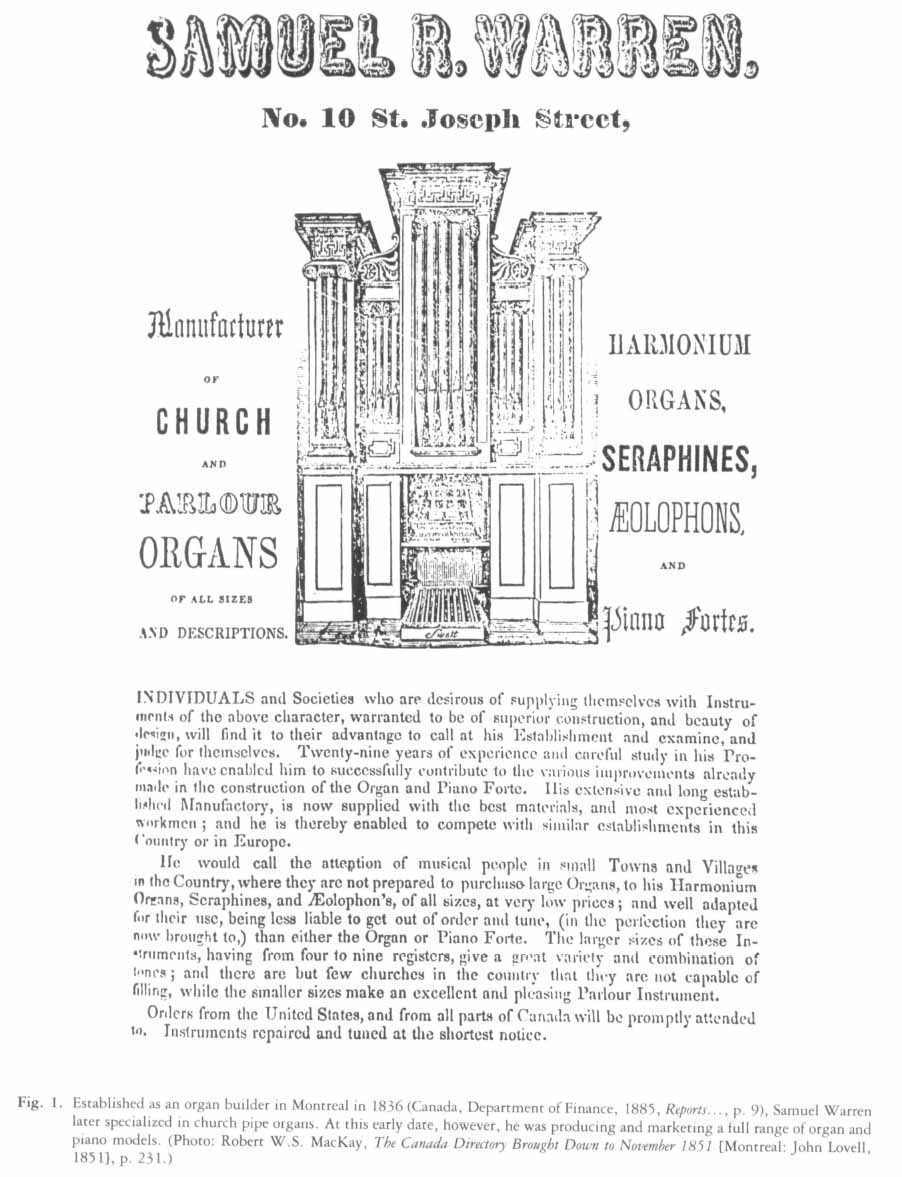 Display large image of Figure 1
Display large image of Figure 1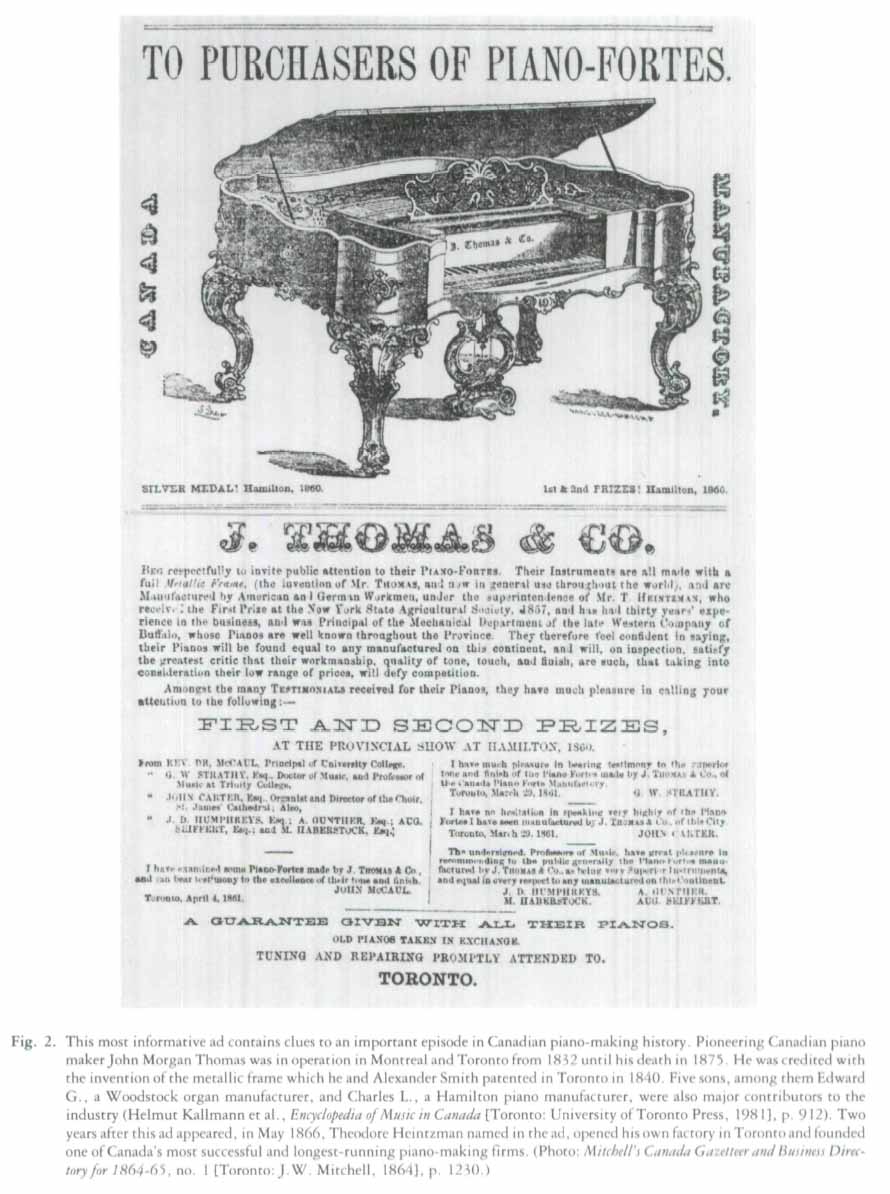 Display large image of Figure 2
Display large image of Figure 214 Potential vehicles for advertising Canadian pianos and organs were many, and manufacturers chose their marketing targets well. The middle and upper income newspaper readers were first on the list. Newspapers were profusely decorated with local advertisements ranging from brief trade notices to lengthy copy with eye-popping typeface combinations.
15 The industry was more selective when it came to periodicals. Instruments were heavily advertised in periodicals with specialized readerships, notably the wealthy classes' "society" magazines such as The Busy Man's Magazine (Toronto, forerunner to Maclean's), and The Canadian Magazine (Toronto, 1893+). Farmer's magazines, such as The Farmer's Advocate (London, Ont., 1866+), Farm and Ranch Review (Calgary, 1905+), or Nor'-West Farmer and Manitoba Miller (Winnipeg, 1886) were targeted to sell costly luxury and labour-saving commodities. Pianos and organs, sewing machines, washing machines, cream separators, and the like were heavily advertised. Music periodicals for the music professions, music lovers, and the trade flourished in Quebec and Ontario since the first issue of Canadian Musical Review appeared in Toronto in 1856.6 The music and instrument trade itself published a journal, Canadian Music Trades Journal (Toronto) from 1900 to 1933.7 The trade was also well represented in various industrial and manufacturing journals such as Industrial Canada (published in Toronto by the Canadian Manufacturers' Association since 1900).
16 City and region business and commercial directories, issued in vast numbers since the mid-nineteenth century, performed a promotional and information service to their readers and subscribers much like the telephone directory today. The directories also carried a prodigious amount of advertising. Other commercial reviews and annuals, such as The Canadian Almanac series (Toronto, 1847+) were similarly well stocked with advertisements. The commercial interests of farmers, businessmen, and tradesmen in rural areas of Ontario, Quebec, and the Maritimes were represented in county and regional atlases, while the industrial, trade, and commercial interests of municipalities were served in souvenir albums and promotional collections.8
17 The larger the manufacturer, wholesaler, or retailer, the more visible was his public profile. The larger firms availed themselves of every opportunity for self-promotion. Theirs were the periodicals with the largest circulation, the classified listings in the directories, and the greatest coverage, while the smaller companies contented themselves with the limited readerships in local newspapers and alphabetical listings in the commercial directories.
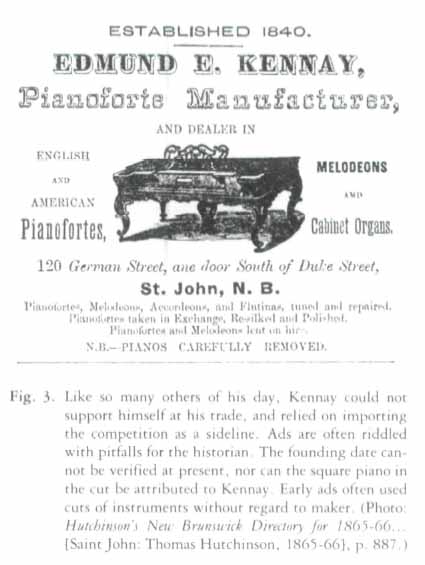 Display large image of Figure 3
Display large image of Figure 318 Advertisements often directed readers to write for free catalogues and price lists. Profusely illustrated and appealingly presented, these mail order catalogues were used by manufacturers, wholesalers, and retailers alike to help the purchaser toward his decision.
19 One advertising vehicle common during the period was not used. This was the general retailer or "department store" catalogue. Manufacturers generally chose instead to market their instruments through specialty music houses, dealerships, branches, and their own salesrooms, rather than in department stores. The few pianos and organs in the general retailer's mail order catalogue were unidentified, or appeared under the name of the house brand.9 In a rare exception, the Goderich Organ Company of Goderich, Onrario, chose to advertise itself in the pages of the T. Eaton Company Ltd. mail order catalogue,10 and that of the Hamilton retailer, Stanley Mills & Company.11 The same company's products appeared in the pages of a school supply wholesaler's catalogue.12 We shall be seeing more of their unconventional advertising moves later.
20 To be effective, advertising had to arouse or intensify the buying and patronage motives on the public's part, whether on an emotional or a rational level, or both. A 1924 merchandising manual identifies twenty-three appeals to emotional buying motives, and ten appeals to rational ones.13 Few such messages were missed in the advertisements of the piano and organ manufacturing industry.
 Display large image of Figure 4
Display large image of Figure 421 In the early decades of the piano and organ industry, with few wholesalers or retailers willing or prepared to take their trade, Canadian manufacturers promoted their own products. By the 1880s, advertising their products had become the job of an extensive network of agencies, dealers, and branches.
22 A surprising number of communities, large and small, in the settled areas of Canada supported specialty music houses since the mid-nineteenth century. In general, dealers such as A. Grossman of Hamilton stocked and advertised keyboard instruments along with brass instruments for military and amateur bands, stringed instruments including violins and guitars, accordions, drums, sheet music, music supplies, and sundries for the wholesale and retail trade.14 But brass band requirements were often their stock in trade, and the proprietor often doubled as bandmaster. For example, George Anderson, a St. John, New Brunswick, piano manufacturer, while "constantly manufacturing Pianos of first class" and "prepared to fill all orders that the public may favour him with," was also repairing brass instruments and accepting orders for the "City Brass Band for Pic-Nics, Parades, Processions, etc.•15
23 In smaller communities or in less populated areas, pianos and organs frequently shared floor and advertising space with sewing machines and other luxury commodities. In 1880, importers and dealers Miller Brothers, of Charlottetown, Moncton, New Brunswick, and Middleton, Nova Scotia, stocked twenty different kinds of sewing machines, organs by three American and one Canadian manufacturer, and an ail-American cast of pianos.16
24 In the less settled west, pianos and organs' salesroom partners ranged from the conventional to the unexpected. In Macleod, Alberta, for example, pianos by the Stanley Piano Company of Toronto could be had along with an ice cream soda,17 while the W. Doherty & Company (Clinton, Ontario) organ and piano agency suffered the somewhat dampening effect of having to share the local undertaking parlour.18
Garnering Support for Home Industry
25 Until the 1860s, specialty music houses and musical instrument importers and dealers did not serve Canadian manufacturing interests overly well, even when, as was so often the case, the importer and the manufacturer were one and the same. John Bagnall of Victoria, British Columbia, was one such example. Formerly with the highly reputed London piano manufacturing firm of Collard and Collard, Bagnall advertised himself as a piano manufacturer early in 1863,19 immediately upon his arrival in Victoria. In 1864 he announced the opening of his piano factory,20 and in 1881, he expanded into organ building.21 Yet in 1885, shortly before his death, he was still taking pains to point out that his company was "Sole Importers of English, French, German and American Pianos, Organs, and all kinds of Musical Instruments...."22
26 These ads were timid about naming their own products. They often tacked them to the end of a list of named imported instruments, almost as an afterthought. A. Laurilliard of St. John, New Brunswick, for example, devoted fully 229 words of copy to his agency for the American Chickering & Sons, W.P. Emerson and G.M. Guild pianos, and Mason & Hamlin cabinet organs, adding at the end: "Mr. L. has a large stock of Piano-Forte Material on hand, and is fully prepared to manufacture and repair Pianos in the most approved manner."23
27 The one concession granted in these early advertisements by music houses was the special provision for local climatic conditions.24 It was later to become an important argument used by domestic manufacturers for supporting home industry.
28 The reason for this indifferent serving of Canadian manufacturing interests was clear. Music houses recognized a fundamental and deep-rooted preference of the buying public for foreign-made luxury commodities, including instruments, over domestic products.
29 In face of this benign neglect on the part of the retailers, Canadian manufacturers campaigned for consumer support of domestic products in varied and innovative ways. In pre-Confederation Nova Scotia, for example, the issue was frequently editorialized in newspapers. Readers of the Halifax piano-manufacturing firm Brockley & Company trade article were reminded that manufacturers were acting in the best public interests, by working to build up the wealth and prosperity of the province. "It is suicidal policy," the article went on, "for our people to send to England and the United States for Pianofortes when the article can be manufactured equally as well and at less cost at home."25 The same newspaper laboured to convince its readers of the rational issues at stake in purchasing a piano from Wm. Fraser & Sons of Halifax. Their money would be plowed back into the local economy rather than fall into foreign hands; the purchase of a warranted instrument would be of no risk to the purchaser; the local manufacturer had his reputation at stake, while the pianos of foreign make would have been made for the foreign market, and, by inference, of indifferent quality.26
30 With Confederation behind them, advertisers turned to the economic motive of the savings-minded consumer. John Nitschke's piano manufactory of London, Ontario, used this appeal to good advantage in his advertisement: "Parties favoring this establishment with their patronage will find it greatly to their advantage; as they can obtain a first class Instrument at a moderate price, not having to pay all the expenses connected with the Trade which import — Duty, commission to Agents, and the enormous Store Expenses, amounting to nearly fifty per cent on the original cost."27 Heintzman & Company of Toronto's message was more blunt: "We claim for our Pianos that they are equal to Any important instrument in every respect. We claim that our Pianos are at least $100 or $150 Cheaper than any Imported Pianos of the same class. We hold, therefore, that it is worth affording our Home Enterprise a large support."28
31 The Toronto piano manufacturing firm Mason & Risch followed up a series of testimonials with a challenging note: "The reputation of the Mason & Risch Pianos has been established by the fact that these instruments not only overcame a well-merited prejudice against Canadian pianos, because of their indifferent quality, but have also commanded the unqualified approval of the best musicians in Germany, England, United States, and Our Own Country."29
Rural/Urban Marketing Targets
32 From the very beginning, Canadian rural and urban marketing targets could be distinguished in the tone and pitch of the advertisements in periodicals serving the two populations. To some extent, pianos and organs were separately destined for these two markets.
33 In the mid-nineteenth century, pianos were the exclusive trademark of refinement and culture of the privileged classes, with an elitist advertising campaign to match. The hard-core economics of the situation were simply the cost: $400 for a medium-priced piano — more than a skilled tradesman's annual earnings — as compared to $75 for a parlour organ or melodeon. The price differential between piano and organ and the prices themselves were to remain fairly constant for the next sixty-five years. With increased purchasing power of the consumer and new markets in the expanding economy, however, the piano gradually outgrew its confining image, to become, at the turn of the century, a popular instrument for the masses. In an ad entitled "The Growth of Culture," the Williams Piano Company of Oshawa, Ontario, reflects on the democratization of the piano's image:
Wife milking cow
Daughter spinning yarn
Son thrashing in the barn
All happy to a charm
Daughter at the piano
Madame gaily dressed in satin
All the boys learning latin
With a mortgage on the farm.31
34 According to this anonymous poet, life on the farm had come to a pretty pass by 1871, and the parlour organ or piano was part of the farmer's general undoing. Farmers' journals carried a message to their readers as impassioned and as forceful as those for the urban customers. Indeed, possibly more so, in view of the fact that the advertising message had to carry its force of conviction over greater distances than city newspapers, and the mail orders had to compete with shipments of agricultural machinery and labour-saving devices so popular on farmsteads.
35 Ironically enough for the disgruntled critic, economic considerations were to underlay much of the rural advertising for the trade. An example of the economic force of argument was a trade article for William Bell & Company of Guelph which appeared soon after the poet made his complaint. Entitled "Music for Farmers," it is a lengthy exposition outlining reasons why farmers should bring "the comforts and luxuries of civilization" to their homes:
"While speaking of music..." — the writer finally came to the point, which was to buy melodeons (an early variety of parlour organ) from Messrs. Bell & Company's factory. "Perhaps we are wandering," the writer wrote apologetically, "but we will say briefly what we mean by this long rigmarole Give the girls a musical instrument."32
36 Thirty years later, in 1901, the secretary of the powerful Canadian Manufacturers' Association returned from a tour of western Canada with encouraging news for eastern manufacturers anxious to extend their market. The western Canadian market, he reported in the association's Industrial Canada, was a fertile field, ripe for harvesting. Although the population size was small,
To manufacturers of such lifetime investments as pianos, this must have been welcome news indeed. With the demand for pianos rapidly drying up in the east, manufacturers redoubled their efforts to unseat the parlour organ and stimulate new markets in the western provinces.
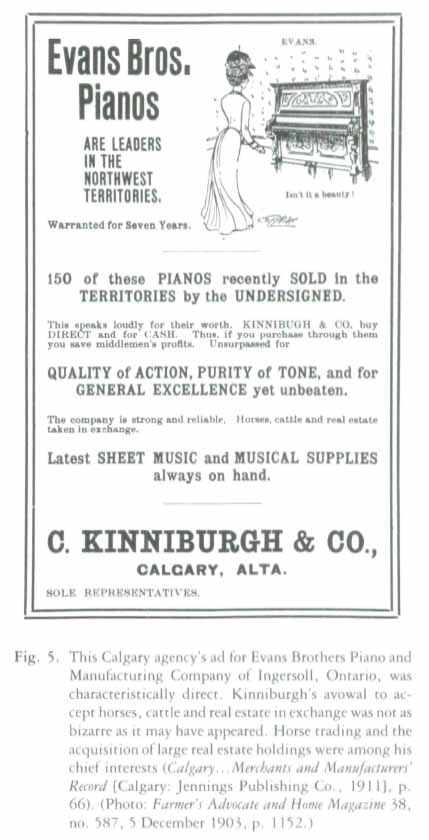 Display large image of Figure 5
Display large image of Figure 537 In their ad for their New Scale Williams piano, the Williams Piano Company Ltd. of Oshawa reminded farm readers: "The day is past when culture and social enjoyment were confined to the larger cities and towns, when the farmer was cut off from the musical world. The day of the parlour organ has passed — or is rapidly passing away. Every farm-house in Western Canada regards a piano...a necessity and not a luxury."34
38 Despite their assertion, the parlour organ continued to linger on in rural homes, long after demand had dropped in the cities. The organ's lighter weight, attractive price to the cost-conscious farmer,35 and farmers' generally conservative attitudes continued to make it a popular choice in rural districts. That the same organ could be rotated around a school district, and made to perform its duty in church, school, and parlour with equal credibility, tripled its serviceability and heightened its desirability. Toward the end of the nineteenth century, while pianos were being mass-produced for sale in the industrial belts of central Canada, organs still played an important part in small-scale cottage industry and home workshops especially in the less populated districts of Quebec, Ontario, and Nova Scotia. The reed organ was thus assured a longer patronage in rural districts of Canada, decades after it was retired from the urban market, and it had found a healthy export market as well.
39 By the 1910s, the day of the reed organ in Canada was fading. As evidence of this, the ever-innovative Goderich Organ Company Ltd. made an impressive effort to combine their organs with their "fine tonal qualities," with their "sanitary woodwork" (toilet tanks and Neversplit scats) in the same ad,36 with less than impressive results. Other strategies were developed to reflect economic and regional differences and the general state of the nation's pocketbook during the swings between good times and bad.
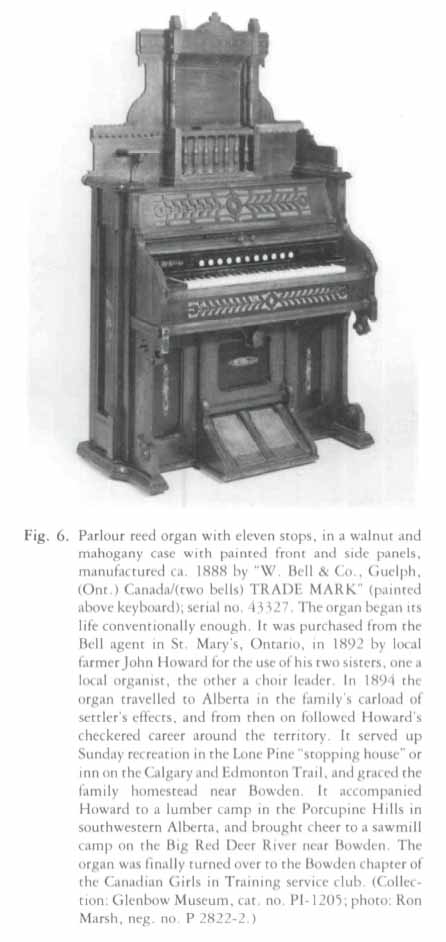 Display large image of Figure 6
Display large image of Figure 6Emotional Buying Motives
40 The copywriters' tactics, whatever their strategy, were unabashedly direct. Threats and promises were resorted to in turn. Perhaps the single most used words were "culture" and "refinement,'' and these were used lavishly. Gerhard Heintzman Ltd. of Toronto, Saskatoon branch, ran this ad in the Saskatoon Phoenix in 1914:
A fine point was drawn by D.W. Karn & Company of Woodstock, Ontario, on the distinctiveness to which their customers might aspire: "The chasm of difference between the average piano and the Karn merely creates distinction, not regality, which is inherent."38
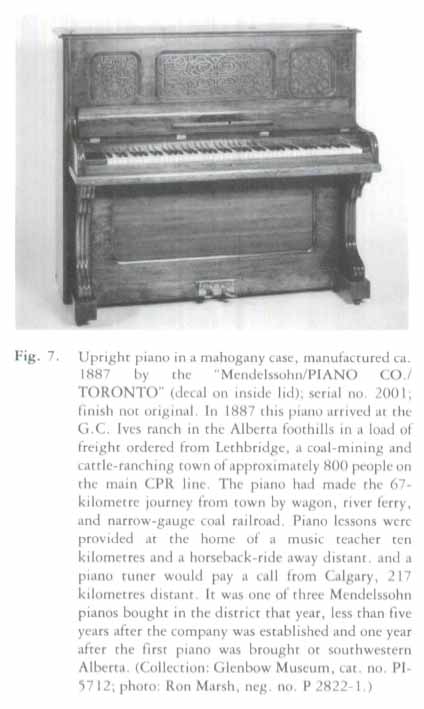 Display large image of Figure 7
Display large image of Figure 7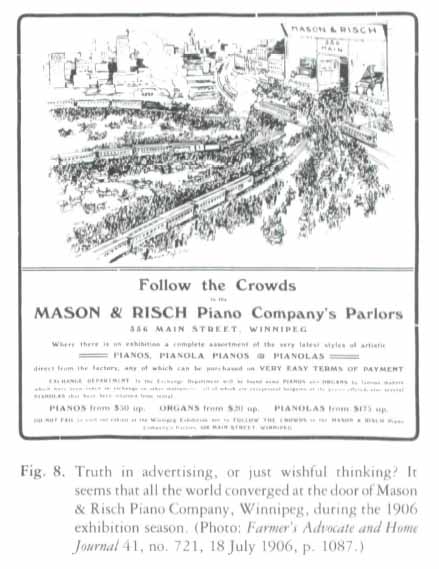 Display large image of Figure 8
Display large image of Figure 841 Many remarks underline home pride. "All the work in the world is directly and immediately undertaken for the maintenance and betterment of the home," Gerhard Heintzman Ltd. reported flatly. "Musically, no refined home is complete without Canada's best piano."39
42 Securing home comfort was the message of the Saskatoon Piano Company Ltd., the agent for Bell Piano & Organ Company of Guelph, Ontario. It also delivered a warning:
The admonishing tone taken toward parental attitudes occurs again and again. "Don't corrupt an otherwise good musical ear by giving your children an inferior piano," warned the Dominion Organ and Piano Company Ltd. of Bowmanville, Ontario.41 D. W. Karn Company Ltd. of Woodstock, Ontario, adopted a more positive tone: "The Pupil should learn on a perfect instrument, or in other words — there being only one — the Karn Piano —, Otherwise the faults of the imperfect piano will permanently affect the technique of the pupil."42
43 The copy writers knew the powerful stimulant of social emulation of the "refined classes": "Mason & Risch Pianos are the Instruments of the Cultured....They are found in the homes of the most refined and cultured people throughout the land....The president of nearly every university or large institution in Canada has bought a Mason & Risch Piano for his own use....Mason & Risch Pianos have been supplied to more clergymen and doctors than all other makes combined." The Mason & Risch Piano Company Ltd. of Toronto capped their appeal by publishing a book of the professional names and addresses, which they mailed out on request.43
44 On the same theme, Heintzman & Company put out "a new piano to be known as The 'Duchess of Cornwall & York' style, modelled along the same lines as the piano used by Her Royal Highness on the Royal Train."44 Not to be outdone, a Williams Piano Company ad listed as its celebrities, Queen Victoria, North West Territories Premier E.W.G. Haultain, and the bandmaster of the 42nd Regiment (Black Watch).45
45 The ads flattered the reader's musical abilities and exercise of artistic taste: "Despite the variety of...good pianos...(available), The Gerhard Heintzman Piano remains the ultimate hope and ambition of nearly every piano player in Canada."46
46 Copy writers did not lack for ammunition in advertising vocabulary, and frequently resorted to extravagant self-praise in rhapsodic, eloquent terms: "Jewels in the piano firmanent" (Bell Organ & Piano Company Ltd., Guelph),47 "The piano with a soul" (Mason & Risch Piano Company Ltd., Toronto);48 "Best in the World" (Dominion Piano and Organ Company, Bowmanville, Ontario);49 "Upon no other pedestal can be reated that work of art, 'The Perfect Piano. ' Upon this pedestal the Gerhard Heintzman Piano looks down upon competition."50 Just as extravagantly, the Dominion Piano and Organ Company Ltd. promised plain talk: "No extravagant claims to mislead intending purchasers. No extravagant testimonials from artists, who are bribed for their opinions. No extravagant prices to inflate values."51
47 "Every woman's world has a piano in it," a Palmer Piano Company Ltd. (Toronto) ad claimed.52 Indeed, ad writers were not adverse to injecting their ads with sex appeal. Women piano players are featured in nearly every illustration, nearly always young, attractive, appearing in admirable decolletage, and often playing to an appreciative male audience.
Rational Buying Motives
Trade fairs and competitions, ranging from local events to those on a regional, provincial, national, or international scale, provided manufacturers with ways to promote their products through both exhibition and competition. Manufacturers fully exploited past successes won at exhibitions by revealing their competition histories to support their claims to excellence. The Newcombe Piano Company (Toronto), for example, claimed to have won the gold medal in competition with 300 of the world's piano manufacturers at the Paris international exhibition in 1900."53 Ten Years Triumphal March!" exclaimed Toronto agent Joseph H. Ruse for Dominion Piano and Organ Company, "Highest Awards Wherever Exhibited! Out Record: — Medals and Diplomas of Honor at all the Principal Universal Exhibitions!" The ad goes on to list awards received at no less than eleven exhibitions from Philadelphia in 1876 to Antwerp in 1885, "and over 100 first prizes in 1883 and 1884."54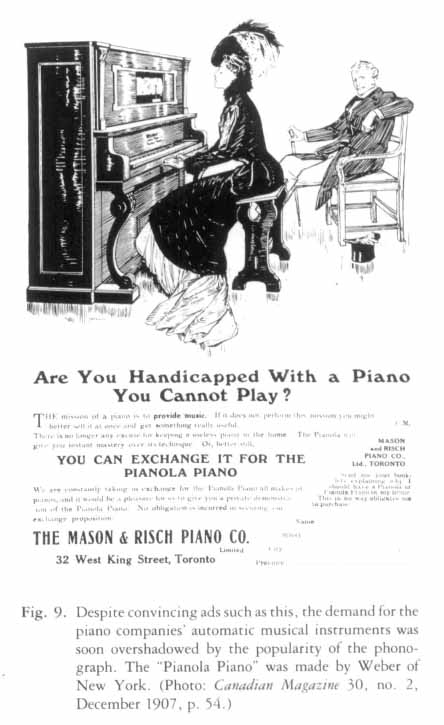 Display large image of Figure 9
Display large image of Figure 948 Affordability ("Every family in moderate circumstances can own a Williams piano"),55 backed by assertions of popular or universal appeal, became an important buying motive. These advertising messages were often sparked with offers of cash discounts, easy credit terms, or savings on agents' commissions by ordering directly from the manufacturer. Other manufacturers delicately reminded purchasers that when the perfect musical instrument or the crowning success of the age was being contemplated, the "price is not a first, nor yet a second consideration."56
49 Ads nudged hesitant purchasers into taking action by alluding to shortages, or the fact that demand had outstripped production: "Shipments are slow, are stopped practically for days at a time.... We know we'll run short on many styles. Orders now can be filled.... Later — no promises....'57 Ads prodded, shamed, and galvanized readers to act. The dealer at Winnipeg Piano Company, offering forty styles of pianos by five American and four Canadian makers, urged: "People of the West — Act!" Stressing year-end piano discount sales due to overstocking, at savings of $100 to $150 per piano and terms of one to three years, he added: "Don't Read This and then wonder if it is really genuine. Men have let fortunes slip through their fingers wondering, while Mr. Wideawake investigates immediately and acts, while others continue to wonder and consider. Remember you have promised to buy a piano for Christmas."58
50 Conversely, manufacturers flattered their readers by crediting them with judicious decisionmaking abilities: "When you have made up your mind to buy a good piano after months of serious consideration... try to choose the best. We prefer your good opinion to your money" (Stanley Piano Company Ltd., Toronto).59 Gerhard Heintzman Ltd. of Toronto took the matter a step further with this persuasive ad:
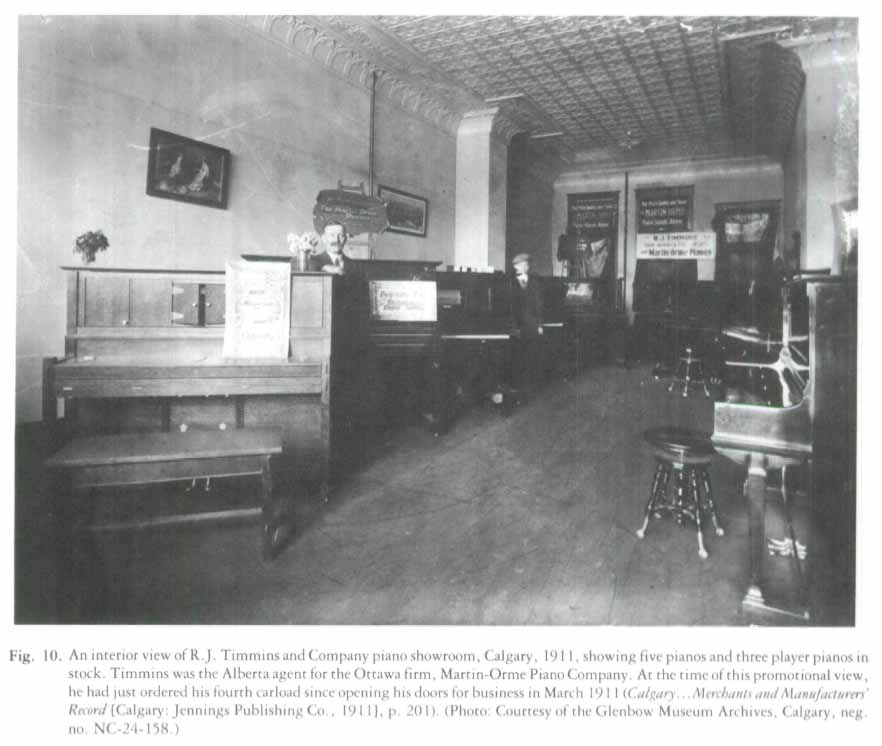 Display large image of Figure 10
Display large image of Figure 1051 Advertising in farmers' journals developed the economic buying motive to a high art. Emphasizing savings above all else, these brash ads hinted at price slashing, price wars, and undercutting in their bids for the consumer's dollar: "The eleven lucky people who secure these instruments will receive the greatest bargains ever offered by the music trade in Winnipeg.... We have no room for anything but our new stock. Rather than store, we sacrifice, and as we have only seven short days to get rid of them, we have set down the ridiculous prices shown." A closer look reveals that the organs offered in the sale are all antiquated, and the pianos are all of the obsolete square variety.61
52 Novel, attractive piano-buying schemes were introduced. The Masters Piano Company of Edmonton introduced a new wrinkle in the easy terms plan: "To introduce our High Grade Masters Piano quickly, without the aid of travelling salesmen, and the expensive method of newspaper advertising, and to make the name a household word throughout Western Canada, we have decided on the following plan." The plan was to offer their new Masters piano at $295 (regular price, $550) to the first five people who sent in their order within fifteen days from the date of the paper. "Pay us no money until the piano is in your home." A $25 deposit with the purchaser's banker sent the piano to his home. If satisfactory, the banker would be instructed to forward the down payment to the company. Monthly payments amounted to $10.62 This manufacturing venture proved to be short-lived.
53 The shrill tone in these ads was being echoed all over the industry. With the new century the competitive fervour among the giant companies had reached feverish levels and bidding for the customers dollar was fierce. A new note had crept into marketing pianos; automatic pianos were now de rigueur, and more and more companies were producing them in order to stay in the running. A general advertising campaign shamed inexpert piano players into giving up their musicmaking attempts and buying an automatic entertainment device instead. This Mason & Risch Piano Company Ltd. (Toronto) ad advised its readers rather tartly: "Your friends don't ask you to play through mere courtesy if your piano is a Pianola Piano — You can give them real pleasure with this instrument. You can play what they like to hear. You do not need to make excuses for your playing. You are never out of practice."63 In 1908, when this ad had appeared, the demand for the keyboard instruments in Canada was long past its peak, and on the downslide. The piano was outmatched and overtaken in the race for the home entertainment dollar by new developments during the first two decades of the twentieth century. The fully automatic player piano was a rather lame solution to the growing appeal of the phonograph. Finally, in the 1920s, the industry was overshadowed by the overwhelming popularity of the radio.